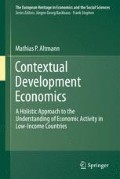Abstract
The application of a style-based framework has been suggested in the preceding analysis as a way to make development economics a more realistic, context-minded science again. Behind this approach lies the idea to conceptualise discrete sets of interdependent economic, cultural and political factors as elements of a particular economic style, and to define the context to which the elements of that style apply as the domain within which generalisations about the behaviour of economic phenomena are possible. While this approach challenges the usefulness of a universal model of behaviour, the possibility of a common framework for explaining economic behaviour in different cultural contexts is retained.
Access this chapter
Tax calculation will be finalised at checkout
Purchases are for personal use only
Notes
- 1.
The theory of the second-best was first laid out by Lipsey and Lancaster (1956) who showed that the absence of any of the jointly necessary theoretical conditions for an optimal allocation of resources does not imply that the next-best allocation is secured by the presence of all the other optimality conditions. Rather, the second-best scenario may require changing other variables away from the ones that were originally assumed to be optimal. This implies that the second-best interactions may significantly differ from those predicted by the first-best model. Unlike in theoretical models, economists may not know, in practical situations, the necessary and sufficient conditions for achieving an economy-wide, first-best allocation of resources.
Author information
Authors and Affiliations
Corresponding author
Rights and permissions
Copyright information
© 2011 Springer Science+Business Media, LLC
About this chapter
Cite this chapter
Altmann, M.P. (2011). Conclusions. In: Contextual Development Economics. The European Heritage in Economics and the Social Sciences, vol 8. Springer, New York, NY. https://doi.org/10.1007/978-1-4419-7231-6_14
Download citation
DOI: https://doi.org/10.1007/978-1-4419-7231-6_14
Published:
Publisher Name: Springer, New York, NY
Print ISBN: 978-1-4419-7230-9
Online ISBN: 978-1-4419-7231-6
eBook Packages: Business and EconomicsEconomics and Finance (R0)

